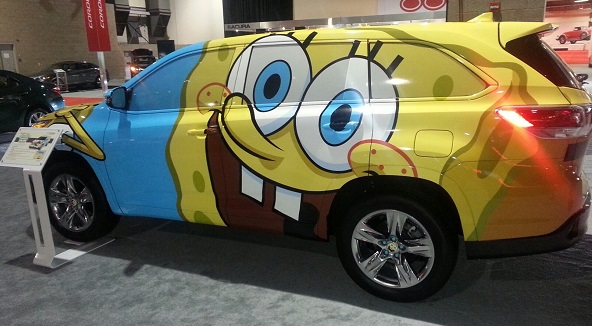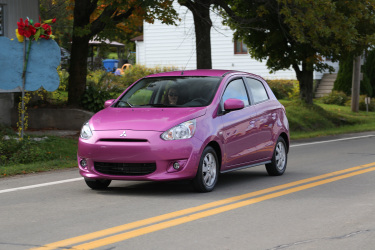2013 Seattle Auto Show: The view from Sehome Hill

SpongeBob wrap is a one-off… fortunately. (Seattle Auto Show photo)
For the first time in a couple of decades, I had to miss the Seattle Auto Show. Did I mention I was in hospital for a month and a half? I now have a more partial right foot than before, and I decided trying to walk a couple of miles at CenturyLink Events Center so soon after being released was not a good idea, at least not with the shoes I have. So this year’s story is going to lean heavily in the rant direction, with things I’ve heard secondhand sprinkled here and there. The show organizers have been making steady, meaningful improvements in the last few years; this year, I’m sorry to have missed it.
As always, if this is of no interest to you, there are nearly 600 posts about scooters for you to explore. Read my rant after the jump.
BELLINGHAM—You may have noticed this post is appearing almost a month earlier than it used to. Having the Seattle Auto Show in November never made a whole lot of sense, unless one was looking to sell cars, which is what they used to do at this show, but then that was probably the only time the building once known as the Seattle Center Coliseum was available. Well, in supposedly progressive Seattle most things are done the way they are because that’s the way they’ve always been done.
There being no last-minute bankruptcies (unlike last year, when Amercian Suzuki Motors filed less than an month before the show), the show floor boasted 500 vehicles, about 100 of which came from the LeMay Museum in Tacoma. This has become a real crowd-pleaser, and a welcome nod to the idea that there are people in Seattle who like cars.

1976 Ferrari Formula 1 car, owned by Tacoma-based Griot’s Garage (Seattle Auto Show photo)
The star of this year’s show was a 1976 Ferrari Formula1® car with Niki Lauda’s name on it, apropos the release of Ron Howard’s messy, tawdry racing soap opera, Rush. While it’s quite possible Niki Lauda actually drove this car, Enzo Ferrari was entirely unsentimental about his race cars… each was merely a collection of parts that got scrapped when they outlived their usefulness. It’s unfortunate people weren’t able to see just how makeshift F1 cars from this era really were. The requirements for entry on the F1 grid were really easy in 1976—bend some aluminum, mold some fiberglass, buy an engine from Cosworth and a gearbox from Hewland and you were good to go (google “Lord Hesketh” if you don’t believe me). Now? Geez. Like NASCAR and the NFL, Formula1 is more spectacle than sport.
The U.S. auto market, now officially the world’s second-largest (China saw over 19 million new-vehicle sales in the previous year, vs. 15 mil here), had been making a surprisingly strong comeback before reaching a plateau in September. Most folks who are working seemed to be feeling better about their economic prospects. I guess. Especially since the U.S. government called off its most recent game of fiscal chicken just in the nick of time.
Most notable about model year 2014 is the sheer number of redesigned and seriously refreshed models, from all manufacturers. In fact, I can’t think of an automaker doing business in the U.S. that doesn’t have something new.

2014 Corvette Stingray (GM photo)
The ’14 model generating the most buzz among the automotive punditry is, natch, the new Corvette (a yellow 60th Anniversary Edition graced the Chevy stand), which revives the Stingray moniker. Unlike the original, however, its near-$50K pricetag is out of reach for even the most well-heeled of youth buyers, and a lot of baby boomers as well. Not to worry; wait a decade or so and the price of a used one will be down in Honda Civic territory.

2014 Honda Civic (Honda photo)
Speaking of the Civic, dayum, the thing is HUGE now! Some wise soul pointed out that most car companies’ compact (aka C-segment) cars are roughly the same size as their midsize (D-segment) offerings from 10 years earlier, and that’s pretty much been the case with Honda. I once owned a 1980 Civic hatchback that caused friends to ooh and ahh at its ability to swallow 700 lbs of newspaper every trip to the recyclers, but it was not something that accommodated four adults comfortably. And drivng next to semis was a bit stressful. These days, the Fit is much closer in spirit to that old Civic.
A new Fit will come from a new factory Mexico in CY 2014. Previous models were built in Japan, which was problematic for Honda’s bottom line with a yen less than 90 to the dollar. Closer sourcing also means there will be a Fit sedan (bleah) and a Fit crossover (yeah!) in the near future.
There’s not a whole lot of difference in the B-segment. Except for the Toyota Yaris everything comes as a 5-door hatch or 4-door sedan, everything gets 40 mpg, give or take, on the highway, they all crash with a minimum of four stars, if not five. So how do you decide?
Well, there’s the “motorcycle-inspired” instrument cluster in the Chevy Sonic and Spark (why it’s not the same piece in each is puzzling), which I think is kinda cool. Then there’s the Yaris, which has a single, ginormous windshield wiper, something I also find rather cool. The Hyundai Accent sedan has a trunk that’s only slightly smaller than my first apartment; unless you need to carry stuff that’s taller than the base of the rear window, it (and the other B-segment sedans) would probably do nicely, especially their being a grand or so cheaper than the hatchbacks and all.
Not to be outdone by Chevrolet, Ford will offer a Fiesta with a motorcycle engine. Motorcycle sized, anyway. Three cylinders displacing a tiny bit less than 1,000 cubic centimeters, turbocharged, direct-injected, variably valve-timed, and so on, all combine to produce eight more horsepower and a BUNCH more torque than the 1.6-liter atmospheric 4-banger. Which only needs an oil/filter change every 10,000 miles, and a new timing belt every 150,000 miles.

Scion… gone? (Toyota USA photo)
Toyota is finally admitting it no longer sees Scion as a “youth” brand. That’s what it was when it debuted at the 2003 L.A. Auto Show as Toyota’s proactive approach to a customer base that was creeping slowly toward Buick’s average-age level. A wise approach at the time.
But times change. The kids are far more interested in mobile phones than cars (and insurance premiums for young people are so hella expensive, they mostly can’t afford it), so Scion needs to find a new purpose in a market that is presently skewing older than at any time in its history.
While there was some talk of Scion becoming an entry luxury brand, Toyota recently told the 1,000 dealers with Scion franchises that they were free to drop them if they wished. So far, the dealer where I live hasn’t taken the signs down. Not yet, anyway.
In fact, it has been widely reported that the boomer cohort is now the largest group of car buyers. Peak earning years, higher-than-ever new car prices, all that. If a recent drive in a 2013 Ford Fusion was any indication, the industry knows these customers well.

2014 Ford Fusion: Ford sold Aston Martin in 2007… why are they ripping off the Aston Martin nose NOW? (Ford Motor Company photo)
How? The turn-signal lever is not mechanical, it’s electronic. Flick the lever and I’m going to guess it activates a microswitch that turns the blinker on. The lever springs back to its normal position; the blinker switches off when the wheel unwinds. No possibility of driving straight down the road with a flashing turn signal. Brilliant!
Meanwhile, those baby-boomer icons, the Ford Mustang and Chevy Camaro, are soon going to stop being giant Hot Wheels carictures of their 1960s versions—in 2015 the Mustang is going to get an Aston Martin nose like the Fiesta and Fusion, while the Camaro will be rocking the Chevy signature dual-opening grille face a year later.

2014 Subaru Forester (Subaru USA photo)
Subaru’s new-for-2014 Forester is one of only two compact crossovers to pass the latest IIHS crash test (I tend to think the best strategy for driving any of them is to, uh, NOT CRASH, but what do I know?). It got redesigned this year, along with the Toyota RAV4. Like the RAV4, it’s bulkier, taller and has lights that grow out of the body like tumors, the latter trend not confined to compact crossovers. I suppose you just have to do that, but it’s gotten to the point where I have more and more trouble thinking of a new car with looks I like better than its predecessor. Maybe I’m getting old.
Fisker Automotive is deader than dead as you read this. The gubmint-subsidized maker of hella-expensive plug-in hybrid sedans ran into a bunch of serious challenges, the loss of a whole bunch of unsold cars to Superstorm Sandy among them. But really, just how many could they have sold? Probably a whole bunch more, had they been powered by V8 engines. And, oddly enough, a company run by former GM product guru Bob Lutz bought up the last 25 unsold Karmas and is fitting them with Corvette V8s. Yours for about $200K. Or have your own Karma converted for a cool 100 grand. Once again, the free market works its magic.
Ferrari has taken the rather contrarian step of reducing sales. Well, why not? One of the basic premises of luxury goods is exclusivity. You can’t ask a quarter mil for a car that’s almost as numerous as Fiat 500s (well, in the Microsoft parking lots anyway), can you? Of course not.
Fiat/Chrysler CEO Sergio Marchionne is working feverishly to raise the cash needed to buy the 41% of Chrysler shares owned by the UAW retiree healthcare trust fund. Once that deal is done, a couple of interesting developments could transpire.
First off, Fiat’s worldwide headquarters could move to Auburn Hills, Mich. And why not? Just as Europe’s relevance on the world stage has faded, the car market there has been on a steady downward trajectory for quite a while. Nobody is making money building and selling cars there. Nobody. The action is in South America, China, south and southeast Asia. Remember, the U.S. is now the second largest new-vehicle market.

Somehow, I think ‘Chrysler Dart’ just wouldn’t work… (Chrysler Group LLC photo)
The other possibility might be winding down the Dodge brand. Dodge? Yeah. The Avenger will not be replaced when production ends next year, and there’s been talk of retiring the Grand Caravan so as to not duplicate the Chrysler Town & Country minivan. The Charger sells well, and the new Dart seems safe because, well, it’s new. And because it’s built on a Fiat platform that will underpin several upcoming Jeep and Chrysler vehicles. But what’s left? Not much.
Especially since the trucks got rebranded as Rams. My thought was always that this would pave the way for spinning off or selling the truck brand, full-size pickups being strictly a North American thing. But they are a very profitable North American thing, and sales are up. Dodge is a North American exclusive as well; in international markets Dodges have been branded as Chryslers. We shall see.
Once again, no Chinese cars at the SIAS. Yet. Geely, the Chinese company that owns Volvo Cars, has announced its intention to begin U.S. sales in 2015. As you read this, Geely and Volvo engineers are workng together on new platforms to be shared between the two brands. Which is more or less why Geely bought Volvo. Yes, really… the Chinese are not stupid. They’re holding a trillion or so dollars’ worth of T-Bills, remember?
As for what might be the first Geely sold here, they have a C-segment sedan that looks like a knockoff from memory of a generation-before-last Toyota Corolla. Another possibility is a compact crossover, which wouldn’t remind you of anything style-wise, but in a competitive segment would most likely be very well-equipped and a few thou less expensive that a Forester or RAV4. We shall see.

2014 Mitsubishi Mirage (Mitsubishi USA photo)
Wonder of wonders, Mitsubishi made the scene this year! Instead of an i (The World’s Nicest Neighborhood Electric Vehicle™), they parked a 2014 Mirage in an obscure corner. The new Mirage has already debuted in Canada, tho I can’t say how many they’ve sold. It does, however, offer a glimpse into the decline of a once-great car company. A generation ago, Mitsubishi was known for cutting-edge innovation, performance and styling, producing the kind of cars teenage boys would plaster pictures of in their bedrooms. Now? Their cars tend to be me-too lumps of cookie dough, and the new Mirage is the doughiest. It’s not just bland, based on published reviews it also rocks a squishy suspension, dead steering and highly fictionalized gas mileage. It’s priced like a Chevy Spark, yes, but the Spark at least has character to match its name. Come to think of it, so does the Mirage. That’s not a good thing.
I recently learned a new word: Cubanization. It refers to the possibility of new cars, with all their gee-whiz, high-tech gizmos, becoming so expensive people decide to just keep fixing their old cars, as people in Cuba have been doing with those pre-revolución Detroit barges.
My 1995 Escort wagon has a leaky head gasket; I was quoted $1,700 to replace it (a remanufactured engine would run almost five grand). A lot of money, yes, but with well-equipped B-segment cars’ stickers now dangerously close to $20K, it’s not an unreasonable alternative if the car is otherwise sound and in good condition. Especially for the financially ruined, who will probably never qualify for a car loan again. There are a lot more financially ruined people out there than you might think… ![]()




Comments are closed.